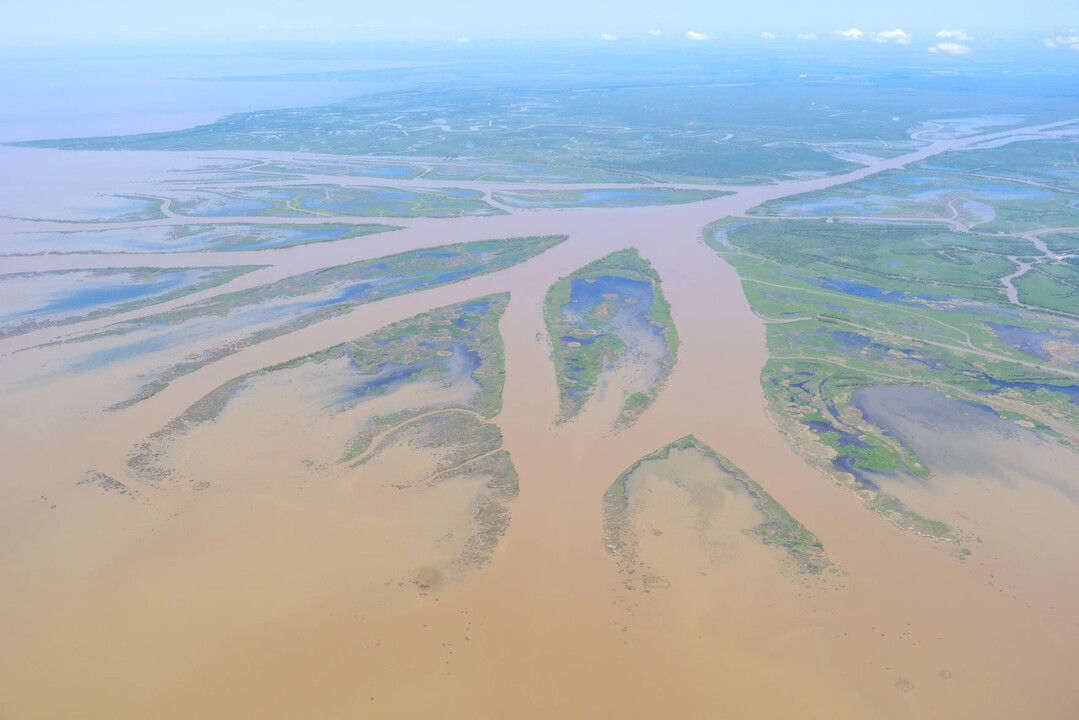
ST. MARY PARISH, Louisiana — Along Louisiana’s rapidly eroding coast, an unexpected glimmer of hope has emerged where the Atchafalaya River meets the Gulf of Mexico. Sediment flowing from a man-made channel, dug decades ago to alter the river’s course, has inadvertently given birth to new wetlands.
This small delta is a modest counterpoint to the vast wetland loss plaguing the surrounding region, but scientists are gleaning crucial knowledge from studying the Wax Lake Delta, insights that could help preserve Louisiana’s coast and contribute to wetland science worldwide.
“Despite sea level rise and storms, the Wax Lake Delta is still there and continuing to build into the Atchafalaya Basin,” said Alisha Renfro, a coastal scientist with the National Wildlife Federation.
A team led by Robert Twilley, a professor at Louisiana State University’s Coastal Systems Ecology Lab, regularly visits Wax Lake to study the principles behind healthy wetland formation. They observe the soil’s chemical makeup and how water moves across the delta, depositing sediment and building land.
“Wax Lake has this long history of researchers who literally wrote the textbook on the definition of a delta,” Twilley emphasized.
Renfro described Wax Lake as a “living laboratory” that eliminates the need for computer modeling, making it the perfect place to study healthy wetlands.
An Unexpected Gift: The Birth of New Land
On a bright February morning, as the research team navigated the bayous of the Wax Lake Delta, part of the Atchafalaya Wildlife Management Area, numerous alligators drifted lazily in the murky water. Jessica Richardson, a data manager with LSU’s Department of Coastal Sciences, noted that the presence of so many apex predators was a testament to the ecosystem’s health.
Flocks of white ibis gathered on the land, and schools of silvery fish darted through the dark water. “You have a diversity of wildlife, like alligators, that nest and lay eggs, and migratory birds that come in different seasons to breed,” Twilley explained.
Deltas form at the mouths of rivers, like the Mississippi or the Atchafalaya, where sediment accumulates. Over time, this sediment creates new land, and the nutrients carried by the river fuel plant growth, whose roots stabilize the newly formed soil, preventing erosion.
Delta wetlands are uniquely diverse and ecologically valuable. Ivan Vargas-Lopez, a wetland scientist and researcher with the Coastal Systems Ecology Lab, explained that when a river flows into a delta, “it’s not just water.” He added, “It’s bringing a lot of nutrients, a lot of sediment, a lot of particles, a lot of material. When the water recedes, that material stays.”
While this process naturally occurs over millennia, the newly formed land at Wax Lake is the result of a serendipitous event.
“Wax Lake teaches us about equilibrium,” said Ehab Meselhe, a river and coastal scientist at Tulane University. “It shows us that if you supply the environment with the right amount of sediment, you can offset the effects of subsidence and sea level rise and build and sustain a healthy ecosystem.”
The U.S. Army Corps of Engineers altered the flow of the Atchafalaya River in 1941 by constructing a channel to reduce flood risk in nearby Morgan City. This initiated the sediment accumulation process, and the results became apparent after a massive flood in 1973 swept an enormous amount of soil downriver.
At Wax Lake, land is built through flooding. Floods carry massive amounts of sediment that spread widely across the delta’s lobed plains at the river’s end. “The delta is forming underneath that water, and it’s like it pops up,” Twilley explained. Over time, this process forms wetlands crucial to the preservation of Louisiana’s coast.
The Key to Reversing Wetland Loss
Subsidence, a slow sinking of the ground, coupled with continued oil and gas development and sea level rise due to climate change, is causing Louisiana’s coastal wetlands to disappear at an alarming rate. These wetlands are some of the most vulnerable in the world, with a significant portion of the coastline vanishing at a rate of about a football field every 100 minutes, threatening the cities, towns, and livelihoods along the coast.
The Wax Lake Delta stands in stark contrast to this trend, expanding by an estimated 1.3 square kilometers of land each year, according to one LSU study. The state of Louisiana and researchers are working to combat the wetland crisis and apply the land-building success of Wax Lake to other coastal restoration efforts, such as wetland creation, artificial oyster reef construction, and barrier island rebuilding.
Dr. Meselhe used data from the Wax Lake Delta in his research on the Mid-Barataria sediment diversion project, which aims to pipe Mississippi River water into the Barataria Basin to combat land loss in the coastal region. The diversion project has been highly controversial due to its potential impact on fisheries and has faced delays and legal challenges.
Wax Lake Delta data helped understand how the interaction between water flow, sediment accumulation, and plant growth builds land. He also examined how land formed in other diversion areas, West Bay and the Bonnet Carré spillway, to analyze how diversions would affect the river itself. This information was then used to calibrate models explaining how the Mid-Barataria project would operate.
“Wax Lake, West Bay, and Bonnet Carré were cases where we had years of data and measurements and maps, so that gave us confidence in the models that we used for the Mid-Barataria area,” Meselhe said.
LSU’s Center for River Studies in Baton Rouge houses a massive model of the Mississippi River, built using information including flow rates and sediment concentrations observed at Wax Lake and other Louisiana deltas. Researchers and students use the model to experiment with how sediment moves and where it deposits along the Mississippi River.
Physical models are useful and necessary, and the Army Corps of Engineers has been using them since the early 20th century. However, Twilley emphasized the critical importance of the on-the-ground observations conducted at Wax Lake. “Models are tools to help you think, not to think for you,” he said. “After you build a model of how these systems work, it’s important to go visit other places to make sure your hypotheses are correct.”
The Diverse Benefits of Healthy Wetlands
As scientists study how Wax Lake builds land, they are also gaining a better understanding of the additional benefits of healthy wetlands, such as natural carbon storage and nutrient reduction.
Jessica Richardson, a data manager with LSU’s Department of Coastal Sciences, describes how the wetlands of the Wax Lake Delta serve as crucial wildlife habitat.
Because Wax Lake has been forming wetlands for decades, Twilley’s lab can compare older and newer wetland areas. “Older delta holds the soil together better and acts as a much better hurricane protection system than the young delta,” he said.
Mature wetlands also store enormous amounts of carbon in the organic matter found in dead plants. This organic matter, buried within the wetlands, prevents microbes from breaking down the carbon and releasing carbon dioxide, a driver of global warming. Wetlands also filter excess nitrogen from the water, preventing it from flowing into the Gulf of Mexico and contributing to harmful algal blooms and the “dead zone.”
Twilley says this is one reason why protecting existing wetlands is crucial; already established systems don’t need to catch up on new functions. “You have to let these deltas mature before they become fully functional,” he added. “If you can take advantage of wetlands that are already there, you have a head start.”
An Uncertain Future
The scientific evidence is clear: wetlands provide numerous benefits, and we know how to create more of them. But the future is uncertain. America’s wetlands face increasing threats. For centuries, wetlands have been drained for agriculture and housing, and despite historical efforts to protect them, current regulations are being rolled back.
The U.S. Fish and Wildlife Service estimated that as of 2019, about 6% of the lower 48 states were covered in wetlands, half the area that existed around 1780. They also found that the rate of wetland loss increased by 50% during the most recent study period. Now, wetlands are disappearing faster than ever due to drainage for agriculture, development, and the impacts of climate change.
Ivan Vargas-Lopez, a researcher with the Coastal Systems Ecology Lab, frequently visits the Wax Lake Delta for his research projects.
According to a series of reports by the U.S. Geological Survey, initiated in the 1980s and completed in 1996, Louisiana’s coastal wetlands account for about 40% of all coastal wetlands in the contiguous United States. The reports stated that “wetlands, which once covered more than half of Louisiana’s area, have decreased to less than one-third of the state’s land area over the past 200 years.”
Changes at the federal level could increase the risk of continued wetland loss.
Environmental Protection Agency Administrator Lee Zeldin has announced plans to redefine the scope of what qualifies as “Waters of the United States (WOTUS)” under federal law. This change affects which bodies of water qualify for federal protection under the Clean Water Act.
The fate of the Mississippi River’s invaluable wetlands hangs in the balance.
The research at the Wax Lake Delta shows that wetlands are more important than ever. Renfro emphasizes that it’s crucial to build more wetlands based on these lessons. “Ultimately, reconnecting the river to the wetlands it once created is the consistent way that we continue to grow a resilient and healthy coastal ecosystem,” she said.
[Copyright (c) Global Economic Times. All Rights Reserved.]






























